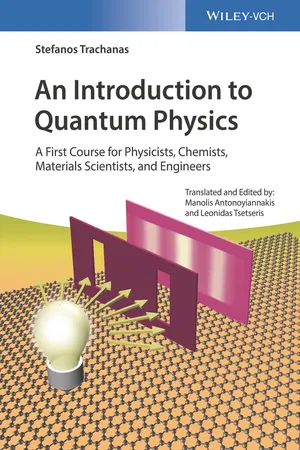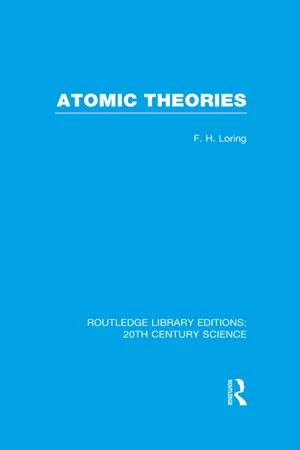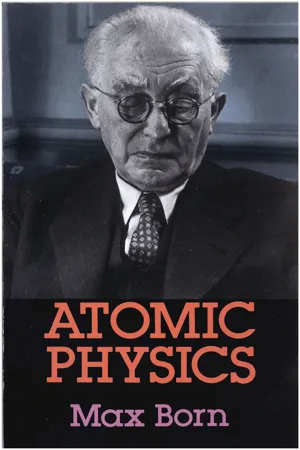Physics
Zeeman Effect
The Zeeman Effect refers to the splitting of spectral lines in the presence of a magnetic field. Discovered by Pieter Zeeman in 1896, this phenomenon occurs when the energy levels of atoms or molecules are affected by the magnetic field, causing the spectral lines to split into multiple components. The Zeeman Effect has been instrumental in understanding the behavior of atoms and in the development of spectroscopy.
Written by Perlego with AI-assistance
Related key terms
3 Key excerpts on "Zeeman Effect"
- eBook - ePub
An Introduction to Quantum Physics
A First Course for Physicists, Chemists, Materials Scientists, and Engineers
- Stefanos Trachanas, Manolis Antonoyiannakis, Leonidas Tsetseris(Authors)
- 2017(Publication Date)
- Wiley-VCH(Publisher)
Then, an electrical discharge excites the atoms, causing them to emit radiation as they return to their initial state. The observation of this radiation yields the spectrum in the form of bright lines on a dark background. So, the question for the experimentalist is how these spectral lines are modified when we obtain the spectrum in the presence of a magnetic field. The answer is provided in Figure 10.5, where we sketched two allowed transitions (and) before and after we switch on the magnetic field. Figure 10.5 The Zeeman Effect. Owing to the selection rules,, each spectral line becomes a triplet, with the middle line positioned at the original one and the other two lines placed symmetrically on either side. The distance between the “Zeeman components” of each spectral line is proportional to the magnetic field. As is evident from the figure, the splitting of the initial spectral line into a triplet is a consequence of the selection rule. Transitions with correspond to a vanishing frequency shift, that is, to the middle component of the line; transitions with correspond to the left component; and transitions with correspond to the right component. This holds for all allowed transitions for arbitrary. Note also that the quantity known as the Larmor frequency, corresponds to the classical frequency of precession of the angular momentum vector for a charged particle in a magnetic field. (The vector rotates with frequency on a cone of constant angle around the magnetic field direction.) But is the splitting of spectral lines large enough to be experimentally observable? This depends on the magnitude of the Zeeman energy,, relative to the energy difference between the transition levels, which is typically on the order of a few eV - eBook - ePub
- F.H. Loring(Author)
- 2014(Publication Date)
- Routledge(Publisher)
Zeeman Effect .It is supposed that when an electron has its motion hastened or accelerated, radiation is given out, and H. A. Lorentz has worked out the precise system of movement necessary to give rise to this effect which, in fact, postulated the existence of negative electrons. The effect may be much more complicated than stated above, as in some cases 13 component lines are brought into existence by the magnetic field, where otherwise there would be only one line, The effect, as is well known, is not limited to the sodium lines since those from other elements are split up by the magnetic field, and G. E. Hale has observed the effect in sun-spot spectra.Sir G. Stokes has shown that in all probability X-rays are light waves of extremely short wave-length (wave-lengths of atomic dimensions) and that these waves have their origin in the sudden stoppage of the swiftly-moving electrons of the cathode stream. In this case acceleration of the electron takes place, and the energy given out as radiation is proportional towhere e is the negative charge of the electron, a its acceleration and c the velocity of light. Now, according to the Lorentz theory, as applied to the Zeeman Effect, in which the magnetic field splits the lines up, at the same time shifting them relatively to the position of the original line, this action could only occur if a very minute negatively charged body of small mass were accelerated in the process. Upon resolving the components of motion necessarily involved, assuming harmonic vibrations, it was found that the results obtained agreed with the behaviour of the spectrum lines as revealed by this effect. According to this theory the shifting of the lines involves a change in the wave-length, which is proportionate to the strength of the magnetic field and the ratio of the charge of the electron to its mass. Runge and Paschen found that under the influence of a powerful field of 24,600 gauss certain mercury lines suffered clockwise (c ) and counter-clockwise (cc ) disturbances with reference to the original line position λo - eBook - ePub
- Max Born(Author)
- 2013(Publication Date)
- Dover Publications(Publisher)
We are now in the region of the Paschen-Back effect. We can describe it in another way by saying that the internal energy of precession about j becomes comparable with the external energy of precession of j about H, so that the fine structure splitting depending on the spin is of the same order of magnitude as the splitting of the terms in the magnetic field. If the magnetic field strength is raised further still, so that the energies depending on the setting in the field become much greater than the energy of coupling between the orbital moment l and the spin-moment s, we obtain the normal Zeeman Effect; in fact, this coupling is then practically completely annulled, and the orbital and spin-moments precess independently round the direction of H (fig. 8). The total magnetic energy is then given by If we continue to denote by m l (a whole number) the projection of l on the field direction, and observe that in this case the spin can only set itself parallel or antiparallel to the field, it follows from the above equation and the half-integral character of the spin-moment that We therefore in this case obtain a term-splitting with the term-separation corresponding to the normal Zeeman Effect. Thus when the magnetic field is steadily increased, a gradual transition takes place from the anomalous to the normal Zeeman Effect; the transitional zone is referred to as that of the Paschen-Back effect. The nomenclature, it may be noted, is not appropriate—normally (at ordinary field strengths) we get the “anomalous” Zeeman Effect, while the “normal” effect is only got at abnormally high field strengths. Fig. 8.—Vector model for the Paschen-Back effect (transition to the normal Zeeman Effect). Since the energy of the orbital moment and spin-moment in the magnetic field is greater than the magnetic interaction between orbit and spin, the orbital and spin-moments precess separately round the field direction. 3
Index pages curate the most relevant extracts from our library of academic textbooks. They’ve been created using an in-house natural language model (NLM), each adding context and meaning to key research topics.


